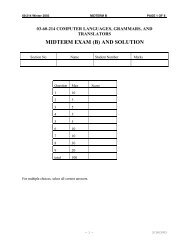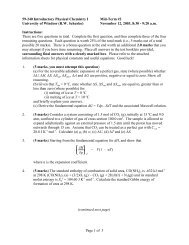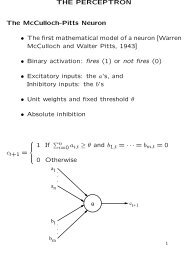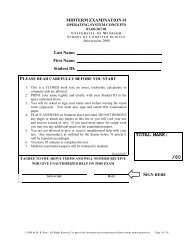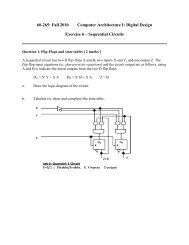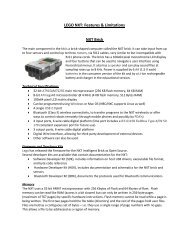03-60-214 Computer Languages, grammars, and translators ...
03-60-214 Computer Languages, grammars, and translators ...
03-60-214 Computer Languages, grammars, and translators ...
You also want an ePaper? Increase the reach of your titles
YUMPU automatically turns print PDFs into web optimized ePapers that Google loves.
<strong>60</strong>-<strong>214</strong> Winter 20<strong>03</strong> MIDTERM PAGE 1 OF 7<strong>03</strong>-<strong>60</strong>-<strong>214</strong> <strong>Computer</strong> <strong>Languages</strong>, <strong>grammars</strong>, <strong>and</strong><strong>translators</strong>Midterm exam (A) <strong>and</strong> solutionSection No Name Student Number MarksQuestion Max Score1 102 53 54 55 56 107 108 309 20total 1001. (10%) Fill in the blanks using the terms listed below.Scanning is also called linear analysis_ or __lexical analysis______. _JLex_____ <strong>and</strong>_Lex__ are examples of scanner generators. The primary inputs to scanner generators are___RE____. When you run the scanner, the primary outputs are _Tokens.scanner, linear analysis, hierarchical analysis, syntax analysis, lexical analysis, lex, regex, Jlex,javaCUP, Yacc, CFG, Parser, BNF, EBNF, RE, DFA, NFA, token, parse tree, DTD, XML,DOM.2. (5%) Nondeterminism of a finite automaton can be viewed as which of the following?— 1 — 2/23/2006
<strong>60</strong>-<strong>214</strong> Winter 20<strong>03</strong> MIDTERM PAGE 2 OF 7(a) when the machine is in a given state <strong>and</strong> reads the next input symbol, we know exactlywhat the next state will be;(b) a kind of parallel computation wherein several processes can be running concurrently ;(c) Several choices may exist for the next state at any point;(d) an NFA, when running on an input string, it has a state with multiple ways to proceed.Your answer: __b, c, d___.3. (5%) If k is the number of states of the NFA, it is always possible to create an equivalent DFAwith at most how many states?(a)k 2(b) 2k(c) 2 k(d) k+ 5Your answer: ___c _____.4. (5%) True or false: (01) * 0= 0(10) * Your answer is:__true________.5. (5%) Giving the following automaton.(a) (2%) True or false: It is an infinite automaton because it can recognize or reject stringsof any length. Your answer: __false_____.(b) (3%) Which string(s) can be recognized by the automata? Your answer is ___i, iii ___.i. 0101000000ii. 0111111000iii. 0000010000iv. 10100000006. (10%) Find a regular expression for language over the alphabet {0, 1} in which all the stringscontain at least two 0's.— 2 — 2/23/2006
<strong>60</strong>-<strong>214</strong> Winter 20<strong>03</strong> MIDTERM PAGE 3 OF 7Your answer: ____(0|1)*0(0|1)*0(0|1)*7. (10%) Describe as simply as possible in English (less than 15 words for each language) thelanguage corresponding to the regular expression(a) (5%) (0|1)*0(0|1)(1|0) Your answer:_any string over {0,1} with the last third digit is0.(b) (5%) a * b(a * ba * b) * a * . Your answer:__any string over {a,b} with odd number of b’s.Solution: A string in the language can start <strong>and</strong> end with a or b, it has at least one b, <strong>and</strong> after the first ball the b's in the string appear in pairs. Any number of a's can appear any place in the string. Thus simplyput, it is the set of strings over the alphabet {a, b} that contain an odd number of b's— 3 — 2/23/2006
<strong>60</strong>-<strong>214</strong> Winter 20<strong>03</strong> MIDTERM PAGE 4 OF 78. (30%) Given the regular expression (a|b)*a(a|b).(a) (10%) Draw the corresponding NFA diagram using the Thompson construction;(b) (10%) Transform the NFA to DFA using subset construction. You need to write thederivation process <strong>and</strong> draw the resulting diagram;(c) (10%) Minimize DFA. You need to write the derivation process <strong>and</strong> draw the resultingdiagram.— 4 — 2/23/2006
<strong>60</strong>-<strong>214</strong> Winter 20<strong>03</strong> MIDTERM PAGE 5 OF 7— 5 — 2/23/2006
<strong>60</strong>-<strong>214</strong> Winter 20<strong>03</strong> MIDTERM PAGE 6 OF 79. (20%) Consider the EBNF definition for if statement in miniJava:stmt à ifStmt| otherIfStmt à if "(" Bool ")" stmt [else stmt]Bool à true|false(a) (5%) Rewrite (i.e., transform) the EBNF definition to context free grammar;(b) (5%) Construct a parse tree for the if statement “if (true) if (false) S1 else S2”;(c) (5%) Prove that the grammar is ambiguous;(d) (5%) Transform the grammar into an unambiguous one.a) stmtàifStmt|otherifStmtàif ( Bool) stmt | if (Bool) stmt else stmtBoolàtrue|falseb) ifStmt/ / | | \if ( Bool ) stmt| / / / | \ \ \true if ( Bool ) stmt else stmt| | |false S1 S2c) here is another parse tree:ifStmt/ / / | \ \ \if ( Bool ) stmt else stmt| / / | | \ \true if ( bool ) stmt S2| |d) stmt àmStmt |uStmtfalseS1— 6 — 2/23/2006
<strong>60</strong>-<strong>214</strong> Winter 20<strong>03</strong> MIDTERM PAGE 7 OF 7mStmtàif (bool) mStmt else mStmt | otheruStmtà if (bool) stmt | if (bool) mStmt uStmt— 7 — 2/23/2006






